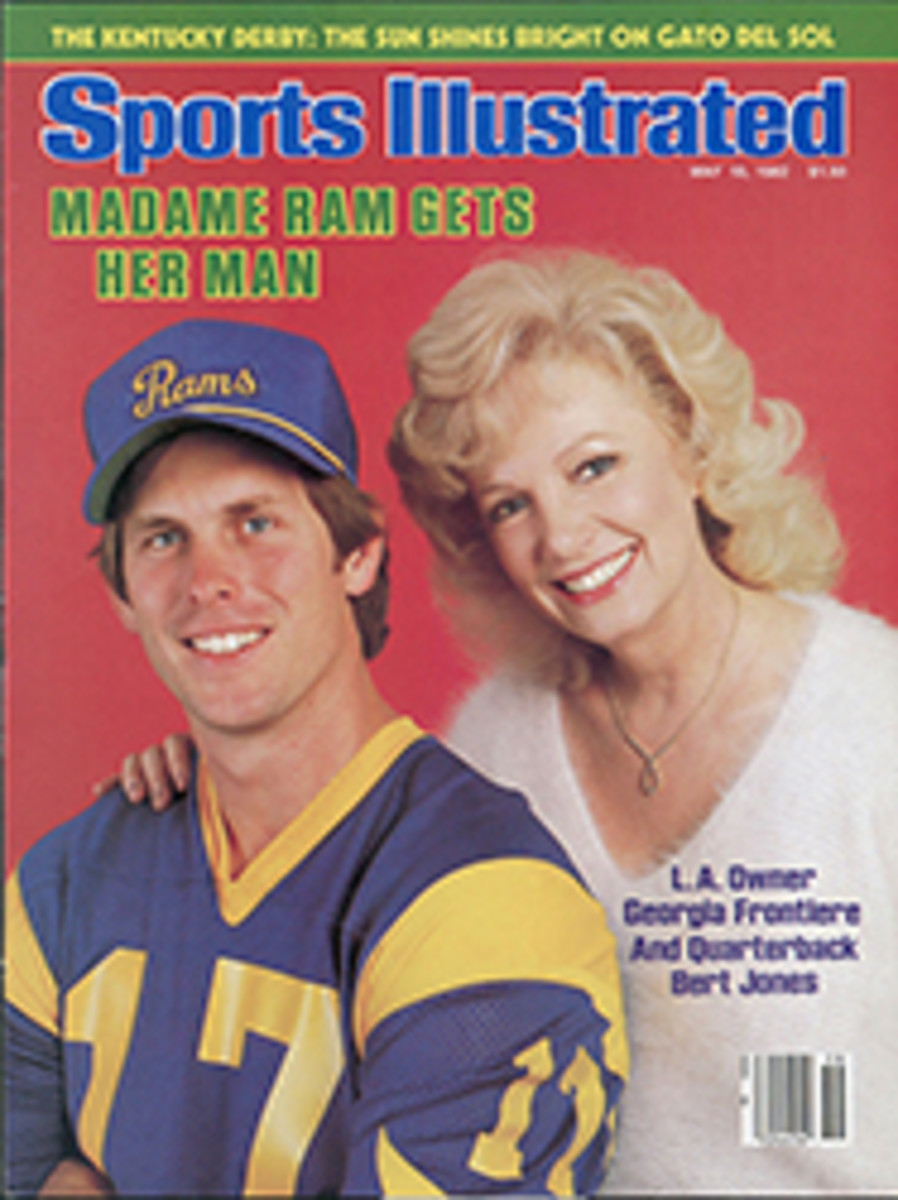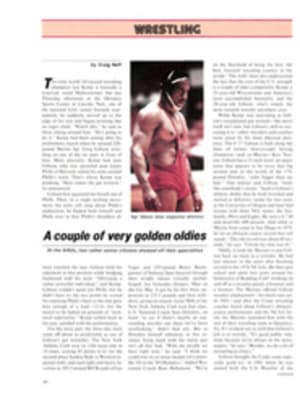
A SELF-TAUGHT FLY-FISHERMAN TELLS OF THE WOES OF LEARNING BY THE BOOK
America's trout streams fairly bristle with fly rods these days, thanks largely to the increasing number of fly-fishing schools. These schools have brought expert casting instruction within the reach of almost everyone who's interested, which is quite a contrast to the way things used to be. There was a time not so very long ago when many would-be fly-fishermen learned casting the hard way—by teaching themselves.
I know, because I was one of them. My only teacher was a book about casting. It was filled with illustrations that made the whole procedure look easy, and it inspired me to purchase a new fiber-glass rod, line and reel and to teach myself to fly cast.
Not having any water conveniently at hand and feeling the self-consciousness of a beginner, I chose an empty pasture as a place to start. It was a cold, snowy weekend in February when I first went out there. The hay had been cut in late summer, leaving a sharp stubble that was now frozen and sticking up through the snow, but I didn't consider the consequences this might have for my new fly line. I was too intent on learning.
Upon consulting the photographs in the book, which I had brought along for handy reference, I soon learned that fly casting is a two-handed proposition: One hand holds the rod while the other keeps tension on the line. This means both hands are engaged simultaneously, doing very different things. It's a little like trying to pat yourself on the head with one hand while rubbing your tummy with the other.
Getting the hang of that was difficult enough, but the real dilemma was what to do with the book. With both hands otherwise occupied, there was no convenient way to hold the book, and the snow would ruin it if I put it on the ground. I tried clutching it between my knees and sticking it inside my belt, but both were uncomfortable. Finally I discovered I could hold it precariously by sandwiching it between my ribs and the elbow of my casting arm, although my casting motion was somewhat inhibited as a result.
(Later, I was to learn that an old British method of casting instruction called for the student to place a book under his casting arm and hold it there by pressing it against his side. This was supposed to teach him to keep his elbow close to his side, which the British apparently considered good form, but I wonder if the tradition wasn't really started by someone who learned to cast the same way I did—from a book he literally couldn't put down.)
The book advised that some beginning casters find it helpful to count out the steps of the cast as they perform them. "The best way to do this is to stretch out the word 'one' through the entire movement of the rod during the back cast," it said. " 'Two' comes at the completion of the back cast as the rod starts forward. And 'three' comes at the completion of the forward cast." I tried it, and it didn't work. By the time I got to "two," the line usually was already on the ground, and I was using four-letter words instead of "one, two, three."
All that day I flailed away in the pasture, pausing only to refer to the book or to pick away at the knots that formed in my line and quickly froze there. The cold seeped through my shoes, and soon my feet were numb, but I didn't mind—perhaps because I was preoccupied with the pain in my casting arm, where the sharp corners of the book were wearing away the skin of my biceps.
Progress was slow, and by the time winter darkness fell in the afternoon, it was all I could do to get out 25 feet of line, and then only about once in every three or four tries. But my feeling of discouragement went away just as soon as I was able to thaw out my feet in front of a wood stove.
The next morning I started out with renewed determination, and results came more rapidly. By early afternoon I had made a long cast of 45 feet and was hitting 40 feet with fair consistency. The knots and tangles were less frequent, and I didn't feel the need to consult the book so often. But just as I was starting to gain confidence, my casts started falling short again. No matter how hard I tried, 40 feet suddenly seemed an impossible distance. Something obviously was wrong.
I stopped then to take a close look at my new fly line, and the cause of my difficulty was immediately apparent. Hours of being beaten on the frozen stubble had worn away the finish on the line, reducing it to a long length of fuzz. It was like trying to cast a 40-foot caterpillar. Fortunately the line was a double taper, the kind you can switch around after one end has worn out. When I did that, 40-foot casts became possible again.
The book described many different casts—the backhand cast, negative and positive curves, switch casts, change-of-direction casts and others. At the outset, I felt I had to learn them all to be a proficient fisherman. But after two days of struggling in the pasture, I decided that being able to deposit a fly in front of me, with the line between the fly and my rod more or less straight, was enough to start with.
For about 10 days after that first weekend I suffered a bad cold and a sore arm, but as soon as the ill effects wore off I resumed practicing, looking forward to the mid-April opening of trout season. Finally the big day came, and I drove to a swampy lake reputed to hold some large brook trout.
Small flies were hovering over the surface of the lake, and when I got out of the car, several of them promptly settled on my hands and neck and bit me. So, following the fly-fisherman's precept of "matching the hatch," I selected a No. 16 Mosquito and tied it to the end of my leader. Then I launched my car-top boat and began rowing slowly along the shoreline, watching for the telltale signs of a feeding fish.
After a while I saw the dorsal fin of a large trout gently cleave the calm surface, leaving an impressive ripple in its wake. Conveniently, it was only 40 feet away.
With mounting excitement, I got to my feet and began switching the rod back and forth, working out line. At what I thought was just the right moment, I let go and threw hard at the spot where the trout had been. Loops of line flew in a great blur, and I was vaguely aware that something had gone terribly wrong. I wasn't immediately sure what, however, because by then my eyes were tightly closed.
When I opened them again I could see the line on the water. It went straight out for about 10 feet, then curved back on itself. I followed it with my eyes, back to the boat, up over the side, down onto the deck, twice around my shoe and up my leg. At about knee level the line ended and the leader began. Tracing it with a finger, I followed the leader up the rest of my leg, past my belt, up to my chin, past my mouth—and into my left nostril. Somewhere inside my nose was a No. 16 dry fly.
Slowly, carefully, I put down the rod. Now I could feel the hackles of the tiny fly tickling the inside of my nostril, and I clenched my teeth and fought back a terrible urge to sneeze. Gingerly—very gingerly—I took hold of the leader, fervently praying the hook hadn't caught inside my nose. Still gritting my teeth, I gave the leader a gentle tug. The fly popped out cleanly.
After that I sat down, shook for a while at the thought of what might have been and wiped my watering eyes. The trout had vanished long ago, of course, and I couldn't get within 40 feet of another one all the rest of that day.
But on my very next trip I caught a few trout, and the trip after that yielded a few more; by the end of my first season as a fly caster, I had good reason to believe that no trout could feel safe if it came within 50 feet of me. What's more important. I was even beginning to feel reasonably safe myself.
Now, after nearly two decades of practice and experience, I can cast just about as far as I want with ease and even hold my own with all those folks who went to the schools. And right about this point, you probably expect the moral of the story—something about how being a self-taught caster builds character, teaches humility and inspires a much greater appreciation of the sport.
Well, you're wrong. The moral is that if I had it all to do over again, I'd go to one of those schools.
ILLUSTRATION
ELWOOD SMITH

